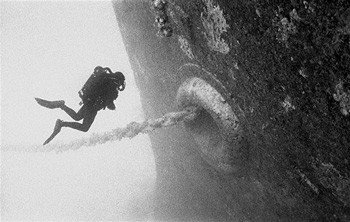A SCUBA device that allows you to recycle what you breathe over and over again is called a rebreather. Your body burns the oxygen you inhale then you exhale the carbon dioxide waste, so a rebreather does the following:
 |
|
There are a variety of designs for rebreathers and their components. For recreational diving the most popular type of rebreather has become the fully closed-circuit breathing loop and is often referred to as a CCR. The loop uses counterlungs to store the gas when you exhale and to supply the gas when you inhale. Also part of the loop is a scrubber canister, which contains chemicals to act as a carbon dioxide absorbent. As the oxygen in the loop is consumed by the diver, the CCR replaces it to maintain a constant level of oxygen known as the set point. The rebreather set point can be controlled using either manual or automatic systems. There are lower cost manual only rebreathers (mCCR) where the diver is responsible for monitoring the breathing loop via oxygen sensors and operating a valve to manually adjust the oxygen level. The most popular closed-circuit rebreather design today is capable of both manual and/or electronic (eCCR) operation. The eCCR uses a small battery powered computer to continuously monitor the oxygen sensors and automatically control a solenoid valve to adjust the amount of oxygen. |
|
Key Advantages of Rebreathers |
Key Disadvantages |
|
|
|
The recreational divers most active in using a rebreather have been photographers because of the benefits in marine life interactions. Technical divers are now very rapidly moving toward widespread use of the rebreather because their efficiency and safety is enabling extended range dives that were previously too logistically difficult or too dangerous. So much so, divers interested in extended range diving should consider switching to closed-circuit rebreather before entering technical training. The new generation of CCR designs have dropped significantly in price, are much easier to use and require only slightly more maintenance than most open-circuit dive equipment. These technological improvements are making the rebreather more common among sport divers. |